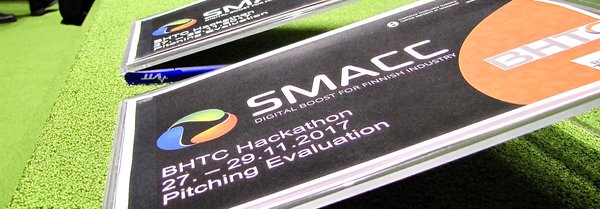The future of automotive interior hacked with success in Tampere, Finland
19.12.2017”An opportunity worth taking.” Business Tampere is organising a series of industrial hackathons in the Tampere Region. In November the local expertise was focused on the automotive interiors in the BHTC hackathon.

The hackathon opening session on the 27th of November: In the near future we will have cars that are more intelligent, able to adapt to individual needs and varying environments; safe, comfortable, energy efficient and probably also shared, not owned. Based on these views the BHTC hackathon brought together people to hack the future of the automotive interior.
– Be creative and do not jump too short when thinking about the new things people will need in their cars in the future, advised Alexander Waldeyer, Manager, Technical Marketing & Patents at BHTC, in his hackathon challenges review.
BHTC, Behr-Hella Thermocontrol GmbH is one of the world’s leading companies in climate control and thermal management for the automotive industry. In 2017 BHTC established a research and development unit in Tampere, mainly thanks to the availability of senior level technology teams in the area at the time.
– Tampere was a very good move for us, to get competence you can’t get anywhere else, Waldeyer says.
In addition to excellent expertise BHTC was also interested in the innovative ecosystem in Tampere, with hi-tech companies, attractive start-ups and high quality research. It was Business Tampere, the Tampere region economic development agency, that first proposed the idea of an industrial hackathon tailored for BHTC needs.
– We thought that a hackathon would a good, quick and fresh way to introduce the variety of R&D&I opportunities that Tampere and Finland have to offer to BHTC, says Senior Business Advisor, Renewing Industry Katja Koponen of Business Tampere.
– It was an opportunity worth taking. We have such good teams participating our hackathon in Tampere: a wide range of companies, students and researchers, says Vesa Pelli, Managing Director at BHTC Finland.
The participating teams had two challenge areas to choose from: well-being and user experience. The BHTC people introduced some of the innovative technologies the company has already developed and brought up with their customers. Teams were encouraged to think of such things as human centered needs, individual passenger control, AI, deep learning and revolutionary HMI (Human Machine Interface) systems–that’s where the future of automotive interiors is.
– Do things that are cool and fun and easy to use, concluded Waldeyer and sent the teams to work on the challenges.

In the BHTC hack the teams had only about two days to put together their ideas and solutions. They also needed to make a presentation for the final session: every team had only 5 minutes to explain and demonstrate their results. To ensure fruitful pitches, a pitching coach was available. The teams could also contact the BHTC advisory board while they were working in case they had something to ask about the subject matter.
The BHTC hack final session on the 29th of December: Back in the Kampusareena auditorium the BHTC jury (Michael Frigge, Vesa Pelli, Alexander Waldeyer, Andre Wälter) had a lot of work to do. Three top teams would receive a prize–but which ones will they be among the 15 participating teams?

The winning team (Erdem Sahin, Olli Suominen, Ugur Akpinar, Ahmed Durmush) is from the 3D Media research group of TUT Laboratory of Signal Processing.
– I think what they did is a true hack: something done in a new way. It is innovative, fresh and feasible, and taking it to a next level is quite simple, says Pelli.
– I too liked the student research approach, and we wanted to honour their creativity, says Andre Wälter, Manager, Corporate Development at BHTC.
The winning team didn’t in fact have to start from scratch since they had already developed the concept in the context of intelligent work machines. The hackathon gave the team a very good opportunity to think how it would work in cars. Doctoral Student Olli Suominen says that the automotive industry is altogether very interesting for the 3D Media research group.
– On one hand, what goes on inside a car when vehicles become more autonomous and the user needs to be kept entertained yet alert. On the other hand, what kind of technology, sensors, cameras and scanners will be needed outside the vehicle, Suominen explains.
– Automotive industry is now transforming more dramatically than ever. We talk about electric cars, autonomous vehicles, Mobility as a Service etc. The technology of future cars has a lot in common with the mobile phone technology, things like identification, UX, UI, mobile payment… This makes Tampere and Finland a perfect location for automotive R&D&I units, says Koponen.

Once the hackathon is over, it is a beginning for another interesting part of the story. BHTC examines the team presentations more closely and opens negotiations when necessary.
– I believe that there will be a day when we introduce something new that originates from our hackathon in Tampere, says Pelli.
– Further to that, all participating teams learned a lot about each other and the hackathon may well be a starting point for new partnerships and cooperation, concludes Koponen.
Hack the future of automotive interior was organised and hosted by BHTC, SMACC and Business Tampere.
Business Tampere and its partners are organising a series of industrial hackathons in the Tampere Region in 2017–2018. Hackathons bring together experts from large companies and start-ups, research and educational organisations to generate ideas, concepts and innovations. Business Tampere will contribute to the further development of the hackathon results to ensure maximum benefits: more productivity, growth, and competitiveness, and closer cooperation among all actors. Hackathons are a part of the AIKO Renewing Industry project.
For more information, please see: hackgo.fi.
